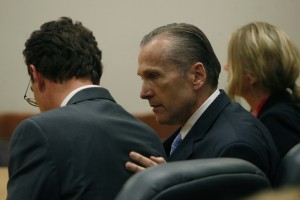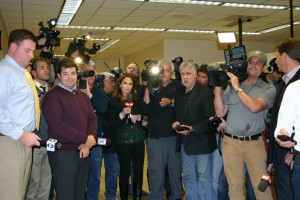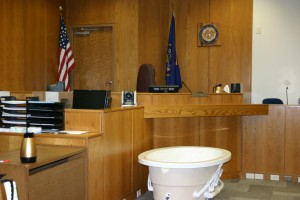
Americans watched as Martin MacNeill was tried for the alleged murder of his wife in 2013. Although his trial officially came to a close with a final sentence on Sept. 19, the new rules that made his case the first live broadcast of a court case in Utah will change the way the public views court proceedings.
When longtime broadcast reporter Robert Walz worked as a reporter, access to Utah’s courts for TV broadcasters was incredibly strict. In fact, cameras weren’t allowed in the courtrooms at all.
“There was one time when I was covering a trial and our cameraman was outside, and when the door opened the light of his camera just shone in the door, and the judge found me in contempt of court,” said Walz, who is currently a professor at BYU. “They were going to put me in jail.”
The court detained Walz for about an hour because of his apparent violation of the judicial code.
“That’s how strict they were back then,” Walz said. “Even the light of the camera was a violation of ‘no cameras in the courtroom.’”
On April 1, 2013, a change in Utah’s judicial code occurred that allowed cameras to enter the courtroom for the first time during the Martin MacNeill murder trial held in Provo.

“I’m a little surprised that the state courts adopted this rule,” said Ed Carter, associate dean of BYU’s College of Fine Arts and Communications. “Utah went from having a very restrictive rule to having one of the most progressive or open rules in the country, kind of overnight. I think that’s good, but just kind of surprising.”
Before the change in the judicial code that occurred on April 1, many electronic devices were prohibited from the courtroom, including cameras. However, since the courts adopted the change, the media response has been greater than anticipated.
“I’m somewhat surprised with all the video requests I’ve been getting,” said Nancy Volmer, public information officer for Utah’s courts. She said she counted almost a hundred requests from April 1 to the end of the year.
Volmer said one of the main reasons behind the rule change was to make the public feel it was not being barred from seeing what happens in the courts. She said allowing cameras in the courtrooms would allow for more transparency in the court system and provide citizens with greater educational opportunities.
Many broadcast journalists, including the director of BYU’s Eleven News, Chad Curtis, thought this rule was a long time in coming.
“The public has the right to know what’s going on in their courtrooms,” Curtis said. “Courtrooms have long been open to more traditional newspaper journalists. To a purist like myself, there’s no difference between allowing newspaper reporters to come in and cover it with pen and pencil and allowing my students or broadcast journalists to come in and record it with camera and microphone.”
Curtis was quick to recognize the relevant differences between a reporter covering a trial for a newspaper and a broadcaster who may cover the same trial.
“It’s very inconspicuous to do a traditional newspaper report,” he said. “A jury member or an attorney may not be able to tell the difference between the father of the defendant and a journalist who is sitting there writing. In relation to cameras in the courtrooms, it’s not inconspicuous. It’s kind of in your face, frankly.”

He said he could understand the concerns judges might have, but he still asserts that rights associated with the First Amendment should make allowing cameras into the courts a “no-brainer.”
Randall Spencer, MacNeill’s defense attorney, voiced his opinions about how increased media access may affect court proceedings, specifically in regard to the behavior of jury members.
“My concern with the new rule is not how it affected me or how I do my job,” Spencer said. “My concern is how it affected jurors, and it just adds one more layer of obvious publicity — obvious potential criticism of how they’re doing they’re job, which I believe either consciously or subconsciously affects their ability to make judgements based on the evidence without letting emotional concerns enter into the picture. How could you not?”
Spencer said he believes there is an agenda in the media to paint the accused parties as bad individuals despite having not heard all of the evidence. He went on to describe how jury members of other high-profile cases, such as the George Zimmerman trial, were “crucified” in the media after they determined the accused was not guilty.
“They’ve got to feel the weight,” he said. “They’ve got to feel anxiety for what may happen to them if they vote ‘not guilty’ in a high-profile case such as this.”
Carter said much of the empirical research that has been done on media effects on juror psychology is inconclusive.
“There’s not a clear answer as to how media coverage affects jurors,” Carter said. “When it’s a high-profile case, like this one was, it’s on CNN every day. It’s online. On the one hand, you could say that jurors can be prejudiced or biased by news coverage even though they’re instructed not to pay attention to news coverage.”
It might help protect the accuracy of the trial.
“News coverage can also be a protection to defendants in terms of scrutiny,” he said. “Public scrutiny allows defendants to be sure that there’s not going to be something inappropriate that’s done. They are going to be sure that the prosecutor and everyone are behaving themselves as they should.”




